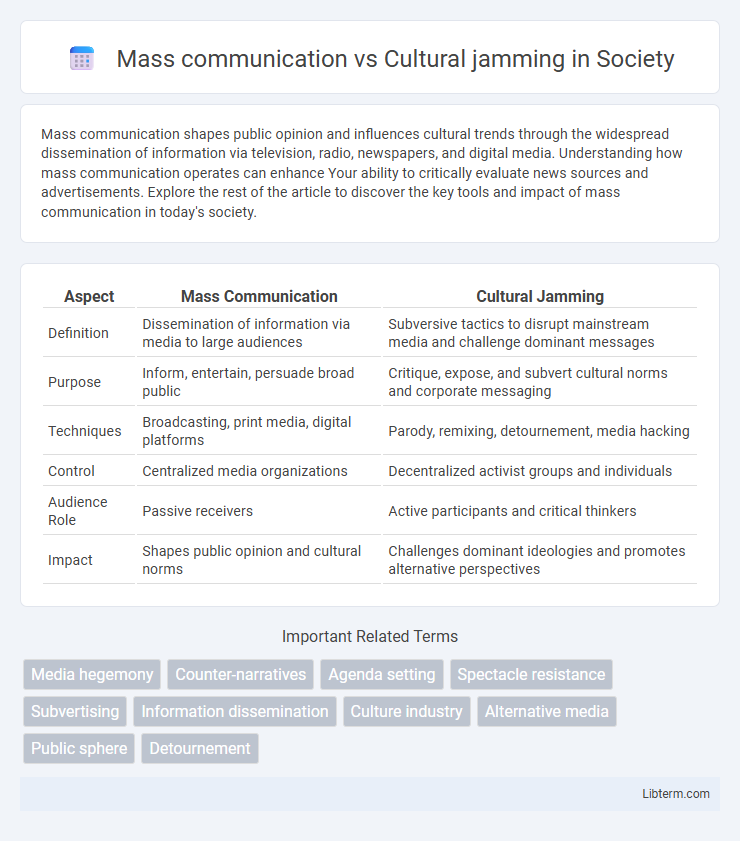Mass communication shapes public opinion and influences cultural trends through the widespread dissemination of information via television, radio, newspapers, and digital media. Understanding how mass communication operates can enhance Your ability to critically evaluate news sources and advertisements. Explore the rest of the article to discover the key tools and impact of mass communication in today's society.
Table of Comparison
| Aspect | Mass Communication | Cultural Jamming |
|---|---|---|
| Definition | Dissemination of information via media to large audiences | Subversive tactics to disrupt mainstream media and challenge dominant messages |
| Purpose | Inform, entertain, persuade broad public | Critique, expose, and subvert cultural norms and corporate messaging |
| Techniques | Broadcasting, print media, digital platforms | Parody, remixing, detournement, media hacking |
| Control | Centralized media organizations | Decentralized activist groups and individuals |
| Audience Role | Passive receivers | Active participants and critical thinkers |
| Impact | Shapes public opinion and cultural norms | Challenges dominant ideologies and promotes alternative perspectives |
Understanding Mass Communication: Definition and Scope
Mass communication refers to the process of disseminating information to large, diverse audiences through media platforms such as television, radio, newspapers, and digital networks. It encompasses the transmission of messages from a single source to a broad audience, aiming to inform, entertain, or persuade. Understanding mass communication involves analyzing its role in shaping public opinion, cultural norms, and social behavior across societies.
What is Cultural Jamming? Origins and Purpose
Cultural jamming is a form of protest that subverts and critiques mainstream mass communication by disrupting messages from dominant media and corporate advertising. Emerging in the late 20th century, its origins trace back to activist groups like the Situationist International and later organizations such as the Yes Men and Adbusters, who use parody and satire to expose consumerism and media manipulation. The purpose is to challenge consumer culture, promote critical thinking, and empower individuals to question media narratives.
Key Differences Between Mass Communication and Cultural Jamming
Mass communication primarily involves the dissemination of information to a large audience through traditional media channels such as television, radio, and newspapers, emphasizing message consistency and wide reach. Cultural jamming subverts mainstream media messages by using satire, irony, and parody to challenge dominant cultural narratives and provoke critical thinking. While mass communication seeks to inform or persuade the public uniformly, cultural jamming disrupts these messages to expose underlying biases and promote cultural reflection.
Mass Communication: Tools, Channels, and Impact
Mass communication employs tools such as television, radio, newspapers, and digital platforms to disseminate information to large, diverse audiences efficiently. Key channels include broadcast media, social media networks, and online news portals, enabling rapid content delivery and widespread reach. Its impact shapes public opinion, influences social behavior, and drives cultural trends through curated messaging and mass audience engagement.
Tactics and Techniques Used in Cultural Jamming
Cultural jamming employs tactics such as subvertising, detournement, and media pranks to disrupt mainstream mass communication narratives by repurposing corporate logos and advertisements with satirical or oppositional messages. Techniques include guerrilla art installations, viral social media campaigns, and spoof advertisements that challenge consumerist culture and highlight social issues. These methods contrast with traditional mass communication's reliance on controlled, one-way messaging strategies designed to influence large audiences through standardized content delivery.
The Role of Media in Shaping Public Perception
Mass communication delivers widely distributed messages through traditional media outlets to shape public perception by establishing dominant narratives and reinforcing societal norms. Cultural jamming disrupts these dominant media messages by subverting and reinterpreting content, encouraging critical thinking and challenging mainstream ideologies. The interplay between mass communication and cultural jamming highlights the media's powerful role in influencing collective beliefs and promoting social awareness.
Cultural Jamming as a Form of Media Critique
Cultural jamming disrupts mass communication by subverting mainstream media messages to challenge consumerism and corporate influence. It employs tactics such as parody, detournement, and guerrilla art to expose and critique the underlying power structures within media industries. This form of media critique empowers audiences to question dominant narratives and promotes critical awareness of the ideological functions embedded in mass communication channels.
Social and Political Implications of Both Approaches
Mass communication operates through centralized channels that shape public opinion by disseminating mainstream narratives, often reinforcing existing power structures. Cultural jamming disrupts these dominant messages by subverting media symbols and narratives, empowering grassroots activism and fostering critical awareness. Both approaches impact social and political dynamics, with mass communication consolidating influence and cultural jamming challenging hegemonic discourse to promote alternative viewpoints.
Case Studies: Mass Communication vs Cultural Jamming in Action
Case studies highlight mass communication's role in shaping public opinion through structured media channels like television and newspapers, exemplified by the 2016 U.S. presidential election campaigns that utilized targeted advertising and strategic messaging to influence voter behavior. In contrast, cultural jamming disrupts mainstream media narratives by repurposing corporate logos and advertisements to challenge consumer culture, as seen in Billboard Liberation Front's interventions that subvert advertising spaces to provoke critical reflection. The contrasting approaches reveal mass communication's top-down dissemination versus cultural jamming's grassroots, subversive activism in media consumption and interpretation.
Future Trends: Evolving Roles in the Digital Age
Mass communication is rapidly integrating artificial intelligence and immersive technologies to enhance audience engagement and personalized content delivery, transforming traditional broadcasting into interactive digital ecosystems. Cultural jamming leverages viral social media campaigns and decentralized networks to subvert dominant media narratives, increasingly using augmented reality and blockchain to amplify activist messages and resistance movements. Future trends indicate a converging landscape where mass communication harnesses disruptive cultural jamming tactics to foster participatory discourse and democratize information flow in the digital age.
Mass communication Infographic

 libterm.com
libterm.com